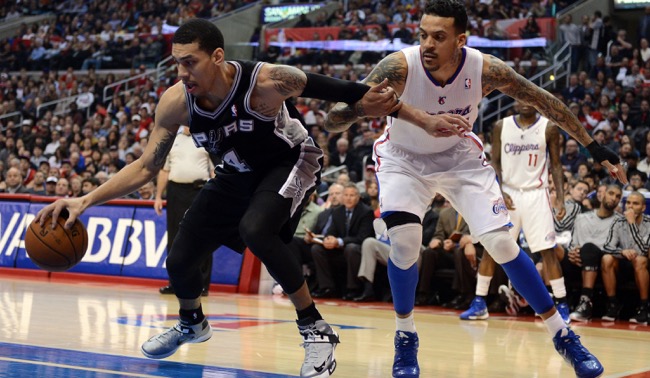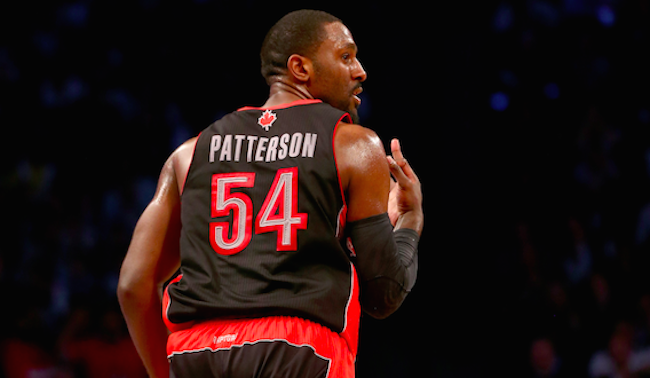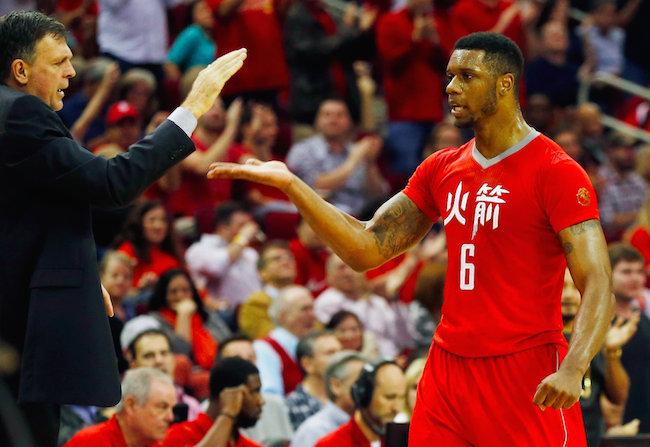
Stars win championships. Anyone telling you differently is lying.
Even anomalous recent title teams like the 2004 Detroit Pistons and 2011 Dallas Mavericks possessed guys like Rasheed Wallace and Dirk Nowitzki at their forefront. But the misdirection of those espousing the merits of team play is only so deep. Superstars indeed hoist Larry O’Brien trophies, but wouldn’t have the privilege of doing so without the many players standing behind them.
Tough the eight national no-names below might never be among those role players crowned as champions, they nevertheless have the ability to swing a series – and thus give their teams the chance for ultimate.
These are the Unsung Heroes of the postseason’s first round.
Kent Bazemore, Atlanta Hawks
Thabo Sefolosha doesn’t start for the Atlanta Hawks, but that doesn’t mean his loss is insignificant. The 6’7 wing is Mike Budenholzer’s best and most disruptive perimeter defender, perhaps the most integral cog of his team’s third-leading opponent turnover rate. Due to Sefolosha’s unfortunate run-in with the New York City Police Department, though, he’ll be sitting the postseason out.
Enter Bazemore, a 25 year-old southpaw with energy, arms, and athleticism for days.
Call this choice one for future rounds. We doubt Atlanta will have much trouble with the Brooklyn Nets, frankly, and Lionel Hollins’ squad doesn’t boast the perimeter offensive threat that will put fear into hearts of the Hawks. Pay close attention to Bazemore stymying isolations, prohibiting open jumpers, and generally wreaking defensive havoc either way, though.
Atlanta needs to replace Sefolosha’s unique impact on that end somehow, after all, and the Old Dominion product is their best bet to do it – he and the San Antonio Spurs’ Danny Green were the only two smalls in basketball this season with steal and block rates better than 2.0 percent. And once the Hawks advance to face a formidable foe, don’t be surprised if Bazemore makes an impact defensive play that changes a game’s complexion.
Tyler Zeller, Boston Celtics
You know all about Timofey Mozgov by now. More than the acquisition of J.R. Smith and Iman Shumpert or even the health and re-commitment of LeBron James, it’s the seven-foot Russian’s January addition that turned the Cleveland Cavaliers’ season around. He may not be a star, but Mozgov’s defensive impact is fully understood.
How can the Boston Celtics combat it? A healthy diet of pick-and-rolls involving Zeller.
Brad Stevens’ starting center is one of the more skilled 5s in basketball. He doesn’t put up huge box score numbers in any category and leaves much to be desired as a rim-protector, but offsets those weaknesses with varied offensive comfort that belies his position. If the Celtics are to have any chance versus the Cavaliers, they’ll need Isaiah Thomas and Evan Turner to consistently crease the paint and create scoring opportunities. The surest way for them to do so? Drawing Mozgov away from the basket, a strategic nuance made easy by Zeller’s shooting prowess.
The 25 year-old shot a scorching 51.5 percent on two-point jumpers in the regular season and boasts just enough off-dribble prowess to attack a hasty close-out. It’s crucial for Boston to get Cleveland scrambling on defense in this series, a possibility far easier said than done given David Blatt’s conservative scheme. If Zeller can feast in the pick-and-pop game, though, the Celtics might be able to do it – and perhaps steal a game or two in the process.
Mike Dunleavy, Chicago Bulls
Jimmy Butler will be consistent. Pau Gasol will go for huge numbers in a game or two. And Derrick Rose will certainly have his moments. Should the Chicago Bulls advance past the Milwaukee Bucks in the first round of the playoffs, though, a far less heralded player could prove just as influential to that development as his ballyhooed teammates: Dunleavy.
The Bulls were wrecked by injuries all season long, but Dunleavy’s month-long absence in January went mostly overlooked. It’s easy to see why, too – the 34 year-old averaged just 9.4 points per game in 2014-2015, and his game doesn’t lend itself to highlights like backup Tony Snell’s. But his marksmanship from range and savvy, if unspectacular, playmaking ability looms large for a Chicago team often short on spacing.
The Bulls’ offensive rating with Dunleavy running the floor this season was 105.8, a full two points better than while he was riding the bench. Their assist ratio and turnover percentage were similarly influence by his presence, too, and Butler’s field goal percentage was 5.6 points higher when he shared the backcourt with the 6’9 veteran. Against a dominant Milwaukee defense that feasts hyper-aggression to create turnovers and general mayhem, the calming aspect of Dunleavy will loom especially large – even before accounting for his 40.7 percent three-point shooting.
Patrick Patterson, Toronto Raptors

Jonas Valanciunas is the Toronto Raptors center of the future, and he’s certainly their most likely center of the present, too. But the young seven-footer is routinely shelved for fourth quarters by coach Dwane Casey, and his slow understanding of defensive concepts isn’t the only reason why, either. It’d just be hard for any coach to keep a player like Patterson off the floor.
The 26 year-old has played more minutes in the final quarter than any other this season, a development owed to his unique two-way impact from the frontcourt. Patterson made 37.1 percent of his three-pointers on a career-high 3.5 tries per game this season, firmly establishing himself as a legitimate stretch big man in the process. And though the Kentucky product isn’t a rim-protector, his foot-speed – when paired with Amir Johnson’s, especially – makes Toronto’s hectic approach to defense that much more effective.
Each attribute will present problems for the Washington Wizards. Space is key to the Raptors’ isolation-heavy attack, and Patterson provides it better than any other big on the roster by pulling his defender away from the ball and strong side of the floor. And with Nené and Marcin Gortat manning the Washington frontcourt, it’s more important than usual for Kyle Lowry, DeMar DeRozan, Lou Williams, and company to see fewer bodies between they and the rim. Against a speedster like John Wall and shooter like Bradley Beal, too, Patterson’s ability to help, rotate, and even switch on defense stands to prove very influential.
He won’t put up huge numbers or even be on the floor every crunch-time minute. But rest assured that Patterson is due a moment in this first round series, and it’s likely to come with the game in the balance.
Ryan Anderson, New Orleans Pelicans
The Golden State Warriors compiled the league’s top defensive rating during the regular season. Why? In addition to boasting a litany of naturally gifted defenders, Steve Kerr implemented a switch-heavy system meant to combat ball movement, negate space, and goad offenses into isolations.
And though it worked exactly the way he imagined, that doesn’t mean it’s a fool-proof strategy. Players like Anderson are uniquely situated to exploit it.
That will only happen if the New Orleans Pelicans’ sharpshooter actually lives up to that billing, of course. The 26 year-old shot a poor 34.0 from beyond the arc in 2014-2015, a career-worst mark mostly attributed to a horrid April. But Anderson’s threat still creates gravity and forces defenses to adjust, and the latter attribute is more important than ever in the matchup-based rigors of postseason basketball.
Will the Warriors revert to switching 1-4 ball-screens if Anderson starts feeling it after popping for a bomb or two? And if so, will he take advantage by bullying Steph Curry in the mid-post with his unorthodox yet effective back-to-basket game? Those questions – and many like them, obviously – are ones that will have to be answered affirmatively for the Pelicans to have any chance whatsoever against 67-win Golden State. And considering Anderson’s easy shooting touch and natural scoring ability, it seems possible for that to happen.
Terrence Jones, Houston Rockets

Injuries have robbed us of finding out how good the Houston Rockets will really be in 2014-2015. With Jones healthy and in the lineup for a first round series against a team like the Dallas Mavericks, though, perhaps we’ll come close to doing so at the very least.
One of the most versatile and underrated defenders in the NBA, Jones presents a unique challenge for Dirk Nowitzki. Players with the requisite combination of length and coordination to confident play in the future Hall-of-Famer’s chest are few and far between. The 23 year-old is certainly among them, though, possessing a 7’2.5 wingspan to go along with quick feet and a sturdy build. In the 178 minutes Jones played with Dwight Howard this season, the Rockets had a defensive rating of 94.2 – a number five points better than Golden State’s league-leading mark.
That’s a small sample size, clearly, but still indicates just how difficult it will be for the Mavericks to score on Houston in the postseason. And because Rick Carlisle’s squad is limited on that end by the presence of Rajon Rondo, it will be forced to bench him, rely on Nowitzki, or both. With a player like Jones – whom Synergy rates as one of the best pick-and-roll defenders in basketball – playing for the other team, each of those options seems like a losing proposition.
Danny Green, San Antonio Spurs

Kawhi Leonard is the San Antonio Spurs’ best player, Tim Duncan their most sweepingly influential, and Tony Parker their most important offensive piece. The two-way worth of no defending champion could mean more to his team against the Los Angeles Clippers, though, than Green’s.
The Spurs are only at their peak offensively when knocking down open jumpers. That’s Green’s role on that side of the ball in a nutshell, of course, and he’s adept at it. The 27 year-old had effective field goal percentage of 65.2 on catch-and-shoot jump-shots this season, the fifth-best mark in basketball. And he’s only getting hotter – Green made a scorching 47.4 percent of his three-pointers after the All-Star break.
But the majority of importance versus Los Angeles lies on the other end of the floor nonetheless. J.J. Redick is one of the few shooters in the league who stands as Green’s superior in that arena, and he’s peaking at the right time, too. If the 6’5 wing can ably navigate a mine-field of off-ball screens to stick with the Clippers’ sharpshooter, it will be much easier for San Antonio to contain Chris Paul and Blake Griffin.
That’s easier said than done, of course, but Green certainly has the requisite combination of physical abilities, understanding, and commitment to do it.
CJ McCollum, Portland Trail Blazers
Injuries mean that the Memphis Grizzlies will be even more focused on stopping Damian Lillard and LaMarcus Aldridge than ever before. Are any of the remaining Portland Trail Blazers equipped to take advantage of extra attention paid to their star teammates? Health assumed, C.J. McCollum is the most likely bet.
The 2014 lottery pick is questionable for Game 1 with a sprained ankle, but represents Portland’s best chance for a tertiary scorer with Wes Matthews and Arron Afflalo sidelined nonetheless. Though McCollum averaged just 6.8 points per game in 2014-2015, that surface level analysis belies crucial context of his sophomore season. Namely, that he went for nearly 16 points a night in April on 53.2 percent shooting.
McCollum is a gifted long-range shooter with the handle of a classic secondary playmaker. He has the tools to feast on the weak side of Aldridge post-ups or Lillard ball-screens, simply taking open jumpers or attacking over-aggressive close-outs with attacks to the paint. And considering Memphis’ defensive prowess this season and his horribly depleted roster, McCollum will need to do just that for the Blazers to have a chance at advancing past the first round.






